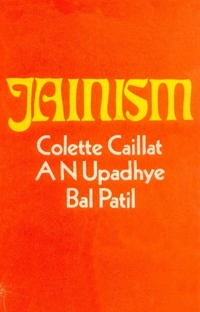However different may be the life and practices of the ascetics and of the faithful laity, the two Jain classes are directed to the observance of vows (vrata), on which is laid thefoundation of their ethics and which, accompanied by the ‘right insight’, guide them to liberation. All the Jains take upon themselves to respect five prohibitions: (1) not to hurt the living beings; (2) not to tell a lie; (3) not to appropriate that which has not been given; (4) not to be unchaste; (5) not to be attached to material possessions. According to the rigour with which they must be observed, they are distinguished in ‘minor’ vows, which the laity accepts, and ‘major’ vows (to which is added that of not eating at night) which are observed by the monks.
It view of the complexity of life in the world, the laymen complete the five preceding vows by seven supplementary rules of morality: quite paradoxically, they take more vows than the monks do. Particular among them are: three efficient vows Which appear to be like particular cases of ‘minor; vows: (1) to forbid oneself all useless action which risks being hurtful; (2) to circumscribe one’s secular activities to a certain perimeter; (3) to impose moderation on oneself; besides four disciplinary vows which facilitate religious life properly speaking: to take upon oneself (i) to meditate several times every day; (ii) to limit one’s occupations; (iii) to fast and to keep vigils at least every fortnight; (iv) to distribute all sorts of alms. Thus regulated, the life of a laymen elevates itself from perfection till it attains the life in religion.
For his part, the monk tries to liberate himself from the bondage of transmigration. Hence, he must purify his soul of the karmic matter by which it is invaded. His preoccupation is twofold; to reject the karman, which, previously accumulated, has not yet ripened; to put a stop to the new influx.
The ‘repelling’ (samvara) of karmic flow is attained by the observance of a series of practices which are found recorded in the canon and systematically instructed by Umasvati: (1) the triple supervision (gupti) of the mental verbal and corporal activity; (2) fivefold care of not hurting any living being (samiti), which obliges to be cautious in walking, speaking, begging, acting, evacuating the various excreta; these are then the ‘eight measurements’ of the doctrine, very often mentioned in the texts and canonic commentaries. They are supplemented by; (3) the observance in a supreme degree of the ten rules of monastic ethic: austerity, continence, voluntary poverty, spiritual obeisance; (4) the practice of twelve pessimistic reflections (anupreksa) on universal impermanence, human weakness, the essential difference between the soul and the body, the world, the influx of karman, its cessation, its expulsion, the rarity of bodhi, the nine principles (navatattvani) which resume the Jain doctrine (influx, cessation, rejection of the karman, the animate and inanimate, merit and demerit, bondage and liberation); (5) the tolerance of twenty-two pains, physical and moral: hunger, thirst, cold, heat, insect-bites, nudity, repugnance for monastic duties, female seduction, peregrinations, study, wretched, lodging, insults, blows, begging, refusal (of alms), ailment, prickings of herbs, dirt, honorific manifestations, insufficiency of knowledge, irritation at not understanding, pride; (6) the righteous conduct, which in its supreme degree, is in conformity with the ideal preached by the Jina. It can be seen that that these observances already present more than one ascetic aspect.
Asceticism, properly speaking, enables the expulsion (nirjara) of karman which, having been previously accumulated, not being realized, remains in the soul and perpetuates its servitude. The Jains distinguish external asceticism (particularly the fasts and the restrictions on nutrients of which they recognize six species) and internal asceticism, alike six fold: (1) confession and penitence; (2) good religious conducts; (3) serving the members of the community;(4)study; (5) meditation; (6) mental concentration or dhyana, at any rate pious and pure dhyana (sukla, ‘white’) dhyana, indeed, which concentrates all the psychic activity on one object, also offers pathological and malicious forms; the recommended forms are the ‘concentration in the religion’ and the ‘ concentration in the self’ each, having four kinds.
So long as the soul carries the least portion of karmic matter, it inevitably follows the round of incarnations of thebody where it lodges, to the distance which separates it from Perfection and Liberation, the Jains define stages of spiritual qualification (jiva sthana or guna sthana), whose sequence is fixed in theory; it does not follow that every faithful has to go successively, exhaustively, through all the stages: according to his actions, the individual raises himself to a certain level, sometimes descends to an inferior level. These are, from heresy to omniscience: (1) the state of error: (2) (3) the partial renunciations; (4) rectitude without renunciation;(5) the partial renunciations;(6) the observance of renunciations with moments of laxity; (7) the concentration in the religion (dharma-dhyana). From this stage, two paths are possible, that of appeasement and, that of the destruction of karman;(8-11) the four stages of the first ‘white’ meditation up to appeasement; at the first two stages, the commentary of Umasvati places the possession of magical powers (rddhi), although it is evidently foreign to spiritual perfection: (12) (in continuation of 7) the second ‘white’ mediation and destruction of aberration. Finally, (13) annihilation for karman: the soul, set free from the enslaving matter isolated (kevalin), and hence, in conformity with its true nature, is pure knowledge. At stage (14) the soul, in a very brief instant, abandons the body.
In our era, the last kevalin was Jambu. One concedes it therefore that, now a days, themonk is possessed of omniscience as soon as he is purified of the four karmas of destruction. After which, the non-destructive karmic species are assimilated with those among them which determine the quantity of life and they are expelled all together.
Liberated from the matter, the soul abandons its fiery as well as physical body at the same time as it gives up its karmic body. In the space of a samaya, it will be stopped necessarily, since the principle of movement ceases at the frontiers of the cosmos. The size of the liberated soul (mukta) is two thirds of that which it had at the last moment of its incarnation in the physical body. In the region, in the form of a cupola at the top of the upper world, it reunites with all the other perfect souls (siddha), equal among themselves (since there is no Sovereign Monad), in infinite numbers, who interpenetrate in such a way that all touch the limit of the universe.
From that moment, the spiritual monad, autonomous, is definitely accomplished being pure knowledge: by the fact that the soul absolutely realizes its profound nature, and by this fact alone, the infinite beatitude of nirvana is attained- or to speak as the Jains generally do, the infinite beatitude of Liberation (mukti), of Perfection (siddhi) is gained.
The path which leads to this accomplishment is that which the souls, predestined for Liberation (bhavyajiva) have no access. Because such is the Law of the world-which, according to the Jains does not depend on any creative or divine power.
It is not rare that the Occidentals find in the Jain dogmatics a somewhat archaic rigidity,that they denounce the restrictive character of the vows- can one say the commandments? - laid down for the faithful monks and laity. However, these opinions tend to change slightly today. One recognizes that a negative formulation Readily serves, in India in any case, for the expression of positive concepts; that the community, while being attached to an illustrious tradition, has made unceasing efforts at adaptation, and that the majority of its masters have, without doubt, been guided by a genuine and human benevolence.
 Bal Patil
Bal Patil
 Prof Dr. Colette Caillat
Prof Dr. Colette Caillat
 Prof. Dr. Adinath Neminath Upadhye
Prof. Dr. Adinath Neminath Upadhye
